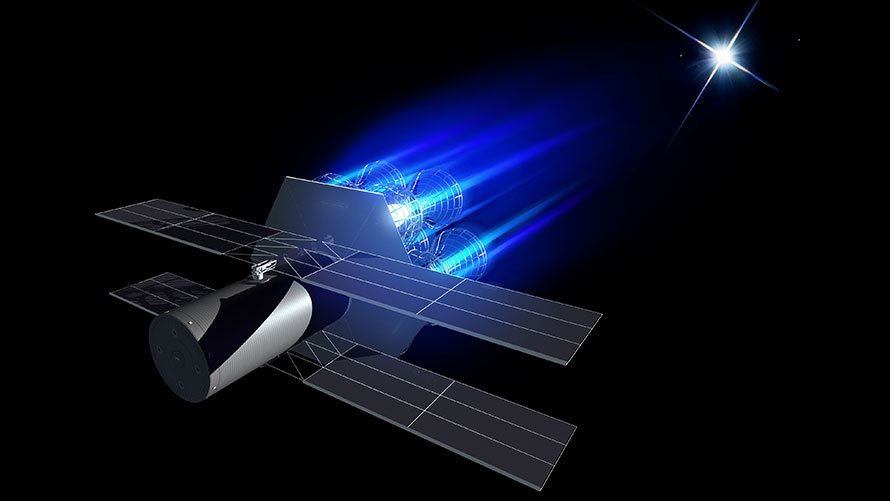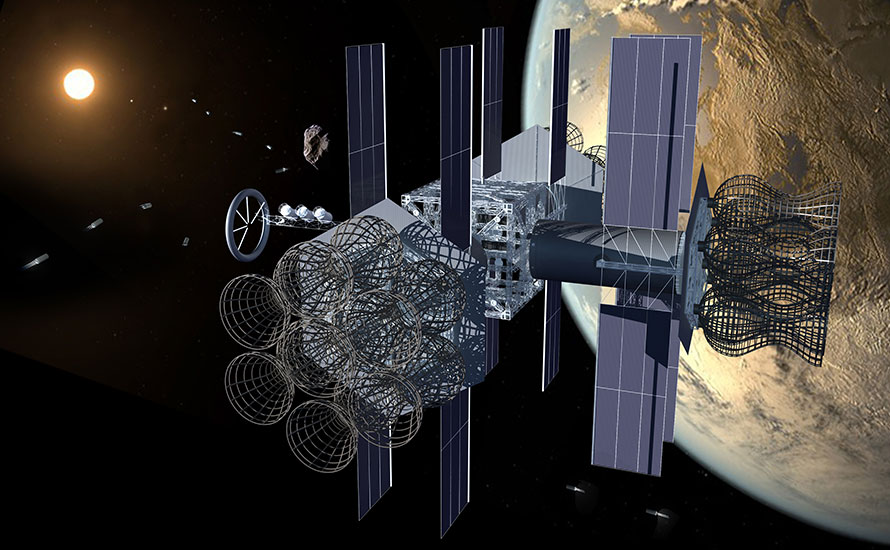Human travel to other solar systems and establishment of settlements in space and/or extrasolar planets in these solar systems.
 Interstellar generation ship doing a deceleration burn with its 7 fusion engines while approaching another solar system. The body of the vessel is a cylinder 3 kilometers in diameter. Attached are large heat radiators. Image: [email protected]
Interstellar generation ship doing a deceleration burn with its 7 fusion engines while approaching another solar system. The body of the vessel is a cylinder 3 kilometers in diameter. Attached are large heat radiators. Image: [email protected]
DESCRIPTION
Interstellar travel requires travel over distances that are hard for humans to visualize. The stars are very far away, the nearest being more than four light years distant, and totally unreachable by any propulsion system currently in existence. However, the expansion of humanity into the universe to live among the stars remains a central dream for many. Interstellar travel would allow human civilization and Earth’s biosphere to spread beyond our solar system, thus improving the probability of long-term species survival. It can be accomplished without using “magic physics,” and this Roadmap does not consider any such “magical” methods.
It is now known that planets are commonplace and some near-Earth-like planets are expected to be found somewhere among the nearer stars. Planets, however, are not needed for human habitation of another solar system because asteroids are likely to be available to support populations in orbital settlements in numbers much larger than what planetary surfaces could support. Thus, detection of habitable or terraformable planets in a star system in advance of a voyage is not required, but may be desirable, whereas the presence of either terrestrial-type planets or asteroids as a material source is required. It is possible that on arrival in a target planetary system, new in-space settlements, along with industrial infrastructure, would be constructed using local in-space materials, before any settlement is attempted on a planet.
In the absence of an Earth-like planet, the vessels will need to carry with them the equipment to build pressurized surface settlements and/or mine asteroids and build rotating space settlements. As the population and in-space industrial base is built up, the human settlers may eventually terraform any suitable planets. In addition to crew and passengers, interstellar vessels may carry frozen embryos or other forms of genetic data which can be reconverted to live organisms for genetic diversity.
Successful interstellar voyages by humans would mark a new phase in the existence of humanity, where humans would be living in more than one solar system.
 Three interstellar generation ships arrive in another solar system and dock at a cubicle structure with a manufacturing facility (all made from parts brought with them) which in turn constructs torus space settlements out of local asteroid material. Image: [email protected]
Three interstellar generation ships arrive in another solar system and dock at a cubicle structure with a manufacturing facility (all made from parts brought with them) which in turn constructs torus space settlements out of local asteroid material. Image: [email protected]
COMPONENTS (1. Some types of interstellar missions)
- Generation ship: A very large rotating space settlement with its own propulsion and energy source which can maintain an artificial biosphere for hundreds of years. Passengers and crew would remain “awake” during the entire trip. The people arriving at the destination would be the descendants of the original voyagers.
- Single generation ship: A ship where the occupants have extended life spans such that most of them are expected to live long enough to reach the destination.
- Hibernation ship: The occupants would be in long term hibernation or cryogenic suspension during the trip, while some may remain awake, or be alternately awakened, to protect the ship and occupants.
- Seed ship: A ship controlled by AI systems, containing frozen embryos or DNA data which is then used at destination to artificially gestate and rear humans. No adult humans are on board. Automated systems would need to produce habitats for the humans to live in from asteroidal or planetary surface resources.
- Interstellar probe: A scientific craft containing no crew or genetic material but able to serve as a technological step toward crewed missions. If a laser and light sail system is used, this vehicle could have a relatively small mass. Ideas also exist for much smaller probes that would be sent in swarms, in succession, and to multiple star systems, by the same laser system. If they are practical, these “star wisps” (named by Dr. Robert Forward), would become invaluable interstellar scouting agents for the human race. The main lower size limitation for such probes is having enough mass and energy to successfully transmit data back to Earth.
COMPONENTS (2. Types of human settlement operations)
Once a human settlement ship has reached another solar system, a variety of operations could begin in order to expand the human population and provide multiple places for them to live. There can be at least six major types of such human operations in a given solar system:
- Mining, transfer and use of space resources in the system.
- Building rotating space settlements.
- Establishment and growth of pressurized surface settlements.
- Para-terraforming – creation of widespread pressurized environments on planetary surfaces.
- Terraforming planets to allow human settlements and Earth plant and animal life to exist on them outside of pressurized environments.
- Construction of interstellar settlement vessels.
BARRIERS
- Lack of propulsion methods (such as the equivalent of fusion or antimatter drives) needed to reach speeds of at least 1 percent of the speed of light, or about 3000 kilometers per second.
- Lack of energy sources such as fusion to support a ship for a century or more.
- Lack of a means of protecting the ship from collision with interstellar debris and to protect the passengers from particulate radiation caused by the ship’s high velocity.
- Lack of methods to sustain a generation ship’s closed ecology for many decades.
- Lack of methods to sustain a generation ship’s motivation and technological expertise for many decades.
- Lack of ability to build new in-space settlements from local asteroidal resources.
- Lack of consensus that sterility of a planet is necessary for practical or ethical reasons and lack of a means of effectively proving that a planet is sterile before it can be used for settlement.
- Lack of a means of terraforming chosen planet(s).
- Lack of multi-decade hibernation and/or cryogenic suspension methods that are reliable and safe.
- Lack of sufficient economic resources and/or political will to undertake the necessary research and construction.
- Belief that interstellar voyages are impossible.
- Political opposition to expansion of human civilization across the galaxy.
COMPLETION
This milestone can be considered achieved when a human settlement is established and growing in at least one solar system besides our own.
MORE OF THE NSS ROADMAP TO SPACE SETTLEMENT:






